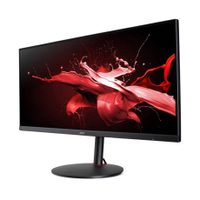These ultrawide gaming monitors are both under $250, making the curved vs flat decision a tricky one
Still, it's good to have affordable choices, yes?

Acer Nitro EDA343CUR | 34-inch | 1440p | 100 Hz | VA | FreeSync | $279.99 $229.99 at Amazon (save $50)
Big ultrawide monitors are a great way to make games even more immersive and enjoyable. The EDA343CUR doesn't have the fastest panel we've seen, but you're getting a huge amount of screen for the money.
Acer Nitro XV340CK | 34-inch | 1440p | 144 Hz | IPS | $299.99 $249.99 at Newegg (save $50)
If curved panels aren't for you, then go flat and in this case, go faster and IPS-er with Acer's XV340CK model. At just $20 more than the EDA343CUR, it's a tricky choice though.
So you want an ultrawide gaming monitor, then? You've decided that you want to step up the level of immersion in your games and realize one of the best ways to do this is to fill your peripheral vision with epic graphics and action. But do you go with a curved monitor or a flat one? Should it have a VA panel for better contrast or an IPS panel for better color reproduction? Those are tricky questions to answer, but at least you've got two great deals on Acer monitors that can fill your ultrawide needs.
To begin with, they're both 34 inches in size, with a 21:9 aspect ratio and a resolution of 3440x1440. That's 33% more pixels than regular 16:9 1440p monitors but 40% less than a 4K one, so you're getting a nice balance between improved visual fidelity and increased workload on the graphics card.
The Acer Nitro EDA343CUR is the cheaper of the two, despite having a 1000R curved screen. That's because it uses a VA panel with a refresh rate of 100 Hz, so it's not the fastest you can get. But anything over 75 Hz gives your eyes a much nicer time, and VA panels are great for high contrast ratios and dark black levels.
For $20 more, though, you could go with the Acer Nitro XVC340CK which has a totally flat screen, using an IPS panel rated at 144 Hz. That's better for your eyes and IPS panels do have better color reproduction than VA ones. A few of us in the PC Gamer office think that if you're going to ultrawide, then having a curved screen just adds a little bit more to the overall sense of immersion.
Acer states that both monitors are HDR10-compliant, but with peak brightness levels of 300 and 250 nits respectively, you probably won't want to use them in HDR mode anyway. Fortunately, both support FreeSync variable refresh rate technology, so you can wave goodbye to screen tearing during games.
Neither model has a feature-rich stand, though, with just a small range in height and tilt on offer. At least both have enough HDMI and DisplayPort sockets to let you connect any gaming PC to them.
So which one to choose—a curved VA panel at 100 Hz or a flat IPS screen at 144 Hz? I'd probably go with the former for outright gaming, even though I prefer IPS panels over VA ones. That 1000R curvature is pretty gentle so it won't take long to get used to it, but it will help the edges of the monitor sit better in the corners of your vision.
Once you've gamed on an ultrawide screen, you may never want to use a regular monitor ever again.
Keep up to date with the most important stories and the best deals, as picked by the PC Gamer team.

Nick, gaming, and computers all first met in 1981, with the love affair starting on a Sinclair ZX81 in kit form and a book on ZX Basic. He ended up becoming a physics and IT teacher, but by the late 1990s decided it was time to cut his teeth writing for a long defunct UK tech site. He went on to do the same at Madonion, helping to write the help files for 3DMark and PCMark. After a short stint working at Beyond3D.com, Nick joined Futuremark (MadOnion rebranded) full-time, as editor-in-chief for its gaming and hardware section, YouGamers. After the site shutdown, he became an engineering and computing lecturer for many years, but missed the writing bug. Cue four years at TechSpot.com and over 100 long articles on anything and everything. He freely admits to being far too obsessed with GPUs and open world grindy RPGs, but who isn't these days?



